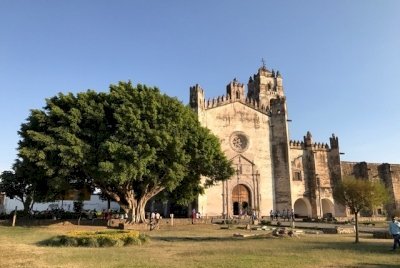
I visited this site around New Years 16/17 during a visit to friends in Cuernavaca. It is not an easy site to visit thoroughly since there are many monasteries and they are all slightly different but to the rushing beholder not very much. It takes an effort to appreciate the individuality of each site. In addition the monasteries are all rather bulky, they look more like fortresses then like churches and that was certainly intentional since missionary time could be dangerous and the local population might not always and everywhere be equally enthusiastic or just willing to adopt the new faith. For me it helps neither that the interior were often converted to baroque style, a fact that makes a visit to latin American churches (and sometimes in Spain and in eastern European countries) a real challenge.
Nonetheless the number of monasteries in a relatively small area and their age are very impressive. Many have impressive facades, others interesting cloisters. Some interiors are extremely plain, others have elaborate gothic constructions. All impress by their seize. The most remarkable feature are certainly the openair chapels and it is not completely clear to me if they were build to worship more in the way the locals were traditionally used to or if the monks didn't allow the locals to enter the sacred space of the church. Perhaps both. Looking back and comparing them makes appreciate almost better then and they seem more various and interesting then I remembered them. As a group they do not only deserve their place but bear witness to a fascinating though for us questionable transition period.
I will try to collect my memories to the churches I visited. At the time my camera had no localization function so I had to compare my pictures with pictures in the internet. Strangely I cannot remember visiting the cathedral in Cuernavaca or find pictures of it so I assume we didn't visit it.
We certainly visited Tepoztlan: I nice, white complex with a beautiful, simple cloister. The most memorable and special place was the room with several toilets seats and each had a poem written on the wall celebrating defecation!!! Even better, and very popular, then the monastery was the beautiful walk to a small Atzek temple on the hill with a fabulous view.
The town of Tlayacapan belongs to the "pueblos magicos". This lable does not always fulfill its promise and I am would certainly not call this small town picture perfect in any respect. Nonetheless, the visit to Tlayacapan was easily the most interesting among the monasteries I visited. The monastery is very large, has a unusual surprisingly renaissance facade and a beautiful cloister and many murals. there is of course an open air chapel and a huge court yard to accommodate a big crowd. The interior of the church is surprisingly and a bit disappointingly simple. What makes this site extremely interesting and what may be easily overlooked are the many chapels spread over the town. There were more then twenty at a time and still 18 in some use. This is not only a huge number for a small town but some of them are also surprisingly big, more the size of a church, and ornate. But most interesting fact is that they were supposedly all build above ancient temples which go back to Aztek or even Olmec roots. The ancient town was organized in for barrios or quarters and each barrio was connected with one of the cardinal directions. Each barrio also had main temple over which the missionaries tore down and replaced a chapel. Each barrio also had a temple marking the entrance to the town which is also replaced by a chapel. So the town looked a bit like a sacred mandala and each temple had a corresponding temple on the opposite site. This tactic had the obvious goal to make the conversion of local people easier by preserving their sacred places. It had or has also the effect that the inhabitants of the town still remember the ancient function of each chapel/former temple and festival rituals related with each christian chapel are supposedly often influenced of even mixed with the rituals related to the ancient temple! I tried to visit a few of the chapels but most I had to be watch contently from the outside. They may only be open on the relating holidays and many may also be closed for dilapidation. I think this is such an incredible history that it would make in my opinion a splendid WHS on its own and I am rather surprised the chapels were not included into the site.
The monastery of Yecapixtla was a surprise for me as the interior, though "baroquified" was a sumptuous Isabelline construction which was at the time colorfully decorated for some festival. From the outside it is very defensive with pointed crenellations everywhere. There is a big square with a wonderful ancient tree in front of the church (picture).
The Exconvento de Santo Domingo de Guzmán in Oaxtepec sits a bit less attractive in the middle of a small town and looked a bit rundown when we visited. But the church with it beautiful late gothic ceiling is a nice surprise.
I think we visited also the Ex Convento Agustino San Mateo Apóstol in Atlatlahucan but I cannot find any pictures a made. The most interesting feature in my memory is the facade and the roof with many crenellations which gave it a kind of fantasy castle look. We also visited at least one more, very bulky monastery quite far up and close to the Popocatepetel probably the one in Tetela. If I ever visit this area of again I might pick up on the remaining monasteries. This is possible since they are located between the rather forbidding but inexhaustible Mexico city and beautiful Puebla which I have visited twice shortly but would well deserve a more thorough visit of several days.
Comments
No comments yet.
